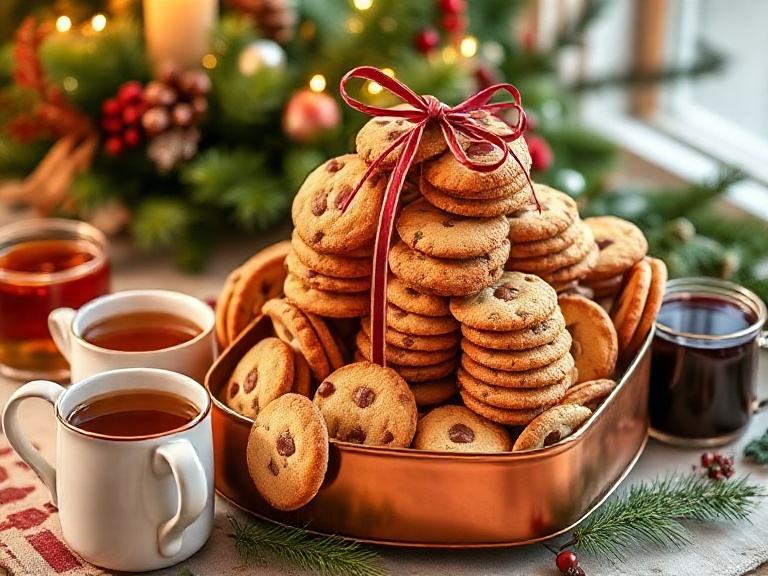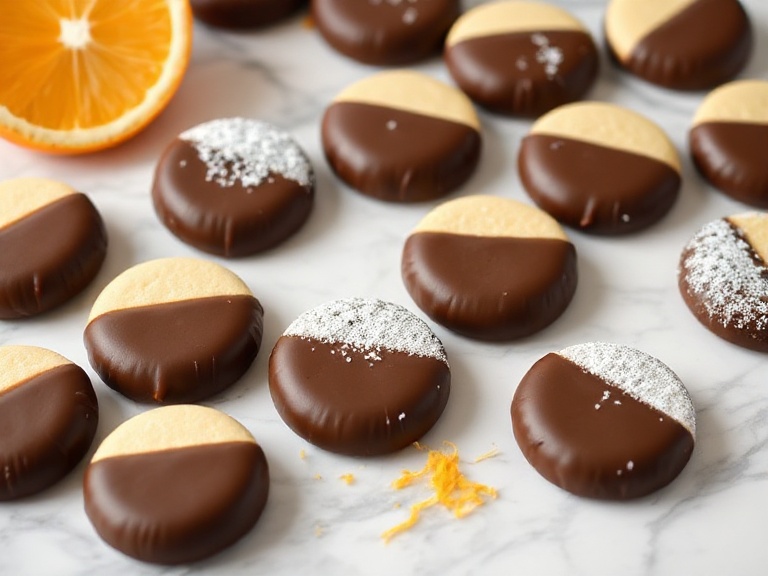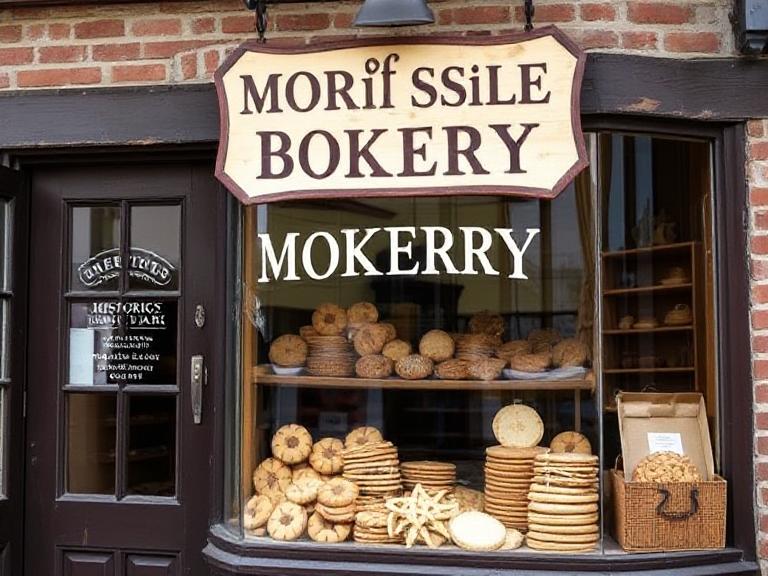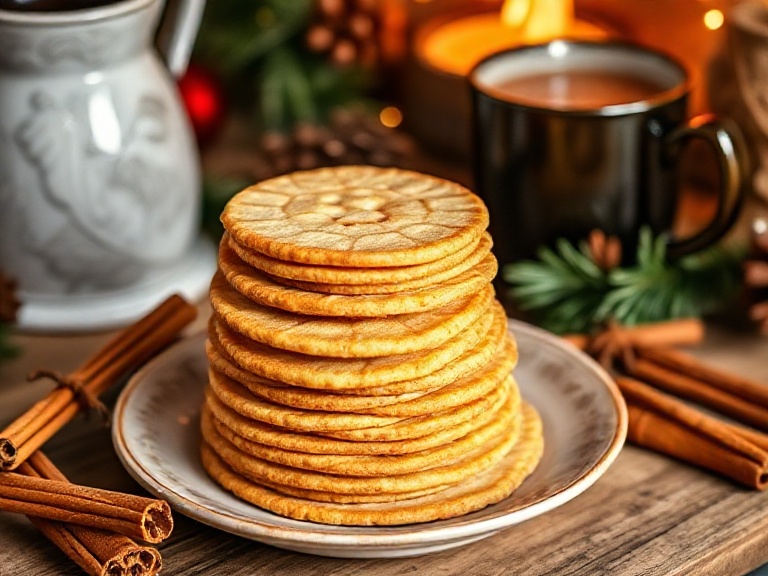The Moravian Cookies Recipe – Crispy Delight Made Simple is a holiday favorite cherished for its thin, wafer-like crispness and warm spiced flavor. Known as the world’s thinnest cookies, these treats have been part of Moravian traditions for centuries, especially in Winston-Salem, North Carolina.
With their delicate crunch and blend of molasses, ginger, cinnamon, cloves, and nutmeg, Moravian cookies are the perfect combination of history and flavor wrapped into one delightful bite.
Making these cookies at home is simpler than it may seem. The dough begins with creamed butter, sugar, and molasses, then enriched with aromatic spices and flour.
After mixing, the dough should be chilled—ideally overnight—to allow the flavors to develop and to make rolling easier. The key to success lies in rolling the dough paper-thin, often between parchment sheets, so the cookies bake into their iconic crisp texture.
Once shaped with cutters and arranged carefully on a baking sheet, the cookies bake for just a few minutes until the edges turn golden. The result is a cookie that snaps when broken and melts in the mouth with spiced sweetness. Variations like honey snaps or chocolate-dipped edges can add a modern twist, while airtight tins ensure they stay crisp for weeks.
Perfect for gifting, holiday gatherings, or enjoying with tea, these cookies are a timeless delight. For step-by-step instructions, ingredient details, and helpful baking tips, see the complete recipe in given below.

The Story Behind Moravian Cookies
The Moravian cookie originated with the Moravian Church, a Protestant denomination that settled in Central Europe during the fifteenth century.
When many Moravians immigrated to the United States, they brought their recipes and traditions with them. In Winston-Salem, North Carolina, these cookies became not only a holiday staple but also a symbol of heritage and community.
What makes Moravian cookies remarkable is their paper-thin texture, achieved through patient rolling and careful baking. These cookies are flavored with warm spices like ginger, cinnamon, cloves, and nutmeg, balanced by the deep sweetness of molasses.
For centuries, families have baked them at Christmas as part of a festive spread. Even today, visitors to Winston-Salem often walk the Moravian Cookie Trail, sampling hand-rolled cookies from bakeries that have perfected the art.

What Makes Moravian Cookies Special?
Unlike ginger snaps or traditional spice cookies, Moravian cookies are much thinner, delivering a crisp and almost delicate crunch that dissolves quickly yet leaves behind layers of spice and sweetness. Their uniqueness comes from three features:
- Texture – The dough is rolled so thin it can be almost translucent before baking. This is why Moravian cookies are nicknamed the world’s thinnest cookies.
- Flavor – They are deeply spiced, usually with ginger, cinnamon, cloves, and nutmeg, all anchored by molasses.
- Tradition – These cookies are not just baked for flavor; they represent family, faith, and heritage.
Moravian Cookies Recipe – Crispy Delight Made Simple
Now that we’ve explored the history, let’s dive into the recipe itself. This method is designed to respect tradition while ensuring modern bakers can achieve the same crisp results without difficulty.
Ingredients You Will Need For Making Moravian Cookies
- 4 cups of all-purpose flour, sifted
- 1 cup of dark, unsulphured molasses
- 1 cup of brown sugar, lightly packed
- ¾ cup of softened butter
- 2 teaspoons ground ginger
- 2 teaspoons ground cinnamon
- ½ teaspoon ground cloves
- ½ teaspoon ground nutmeg
- 1 teaspoon baking soda
- ½ teaspoon salt
- ¼ cup water (optional, only if dough feels too dry)
Steps To Make Moravian Cookies Recipe
Preparing the Dough
To begin, cream the softened butter with the brown sugar in a large mixing bowl. The mixture should become fluffy and slightly pale in color, which indicates that enough air has been incorporated. Next, pour in the dark molasses and continue mixing until everything is well blended.
At this point, the mixture should have a rich, dark aroma thanks to the molasses.
In a separate bowl, sift together the flour, baking soda, salt, and all of the ground spices—ginger, cinnamon, cloves, and nutmeg. This step ensures that the spices distribute evenly throughout the dough. Gradually add the dry mixture into the molasses-butter base, stirring gently until a dough forms.
The dough should be firm enough to roll, but if it feels crumbly or too stiff, a small splash of water can bring it together.
Once the dough is ready, divide it into two disks, wrap each in plastic wrap, and refrigerate. Chilling is crucial, and ideally, the dough should rest overnight. This step not only firms up the dough for rolling but also allows the spices to deepen and meld with the molasses, enhancing the final flavor.
Rolling the Dough Paper-Thin
When the dough is thoroughly chilled, remove one disk and place it between two sheets of parchment paper. Rolling the dough for Moravian cookies requires patience because the hallmark of these cookies is their near-transparent thinness. Using a rolling pin, press the dough evenly until it reaches less than one-eighth of an inch thick. If the dough becomes sticky or too soft, you can return it briefly to the refrigerator. Some bakers even freeze the dough for five minutes before cutting to make handling easier.
The goal is to achieve a sheet of dough that is thin but not torn, flexible yet sturdy enough to transfer. This technique is what creates the signature crunch of Moravian cookies.
Cutting and Shaping the Cookies
Once the dough is rolled to the desired thinness, use your favorite cookie cutters to shape the cookies. Traditional shapes include stars, hearts, or simple rounds.
Because the dough is delicate, lift the cut cookies carefully with a spatula or by peeling away the surrounding dough. Transfer them onto a parchment-lined baking sheet, spacing them slightly apart to allow for minimal spreading during baking.
Baking to Perfection
Preheat your oven to 350°F (175°C). Bake the cookies on the middle rack, one sheet at a time, for six to eight minutes. It is essential to watch closely, as the difference between perfectly crisp cookies and burnt ones can be just a minute.
Rotate the tray halfway through baking for even browning. The cookies should come out slightly darkened at the edges but not overly browned.
As they cool on the baking sheet for a few minutes, they will harden further, developing that signature crisp bite. Once set, move them to a wire rack to cool completely.
Storing the Cookies
When stored in an airtight tin, Moravian cookies retain their crispness for up to two weeks. Layering parchment between them prevents breakage. If they do soften, a few minutes in a low oven can refresh their texture.
Variations to Try
While molasses is traditional, variations such as honey snaps replace it with honey, giving the cookies a lighter sweetness and golden color. For modern twists, bakers sometimes dip the edges in dark chocolate, sandwich jam between two cookies like a Linzer variation, or add orange zest for a citrusy lift.
Common Problems
If your dough is too sticky, it likely needs more chilling time. If cookies turn out chewy rather than crisp, it means the dough wasn’t rolled thin enough. Burnt edges suggest that the baking time or oven temperature needs slight adjustment. Finally, if cookies stick to the parchment, allow them to cool slightly before lifting.

Nutrition Facts (Per Cookie Approximate)
| Nutrient | Amount |
| Calories | 55 |
| Carbohydrates | 10 g |
| Sugars | 6 g |
| Fat | 2 g |
| Protein | 0.6 g |
FAQs on Moravian Cookies Recipe
1. What makes the Moravian Cookies Recipe unique compared to other cookies?
Moravian cookies are famous for being ultra-thin, crispy, and spiced. Unlike most holiday cookies, they are rolled paper-thin, giving them a delicate snap with every bite. The traditional recipe includes molasses, ginger, cinnamon, nutmeg, and cloves, making them both flavorful and aromatic. Their thinness and crunch set them apart from gingerbread or sugar cookies.
2. Can beginners easily make Moravian Cookies at home?
Yes, absolutely! While the dough requires chilling and careful rolling, the Moravian Cookies Recipe – Crispy Delight Made Simple is very approachable. Beginners just need to ensure the dough is rolled extremely thin (sometimes using parchment paper) and baked quickly at the right temperature. With patience and practice, anyone can master them.
3. Why is it important to chill the dough overnight?
Chilling helps the dough firm up, making it easier to roll thin without sticking. It also allows the spices and molasses to meld together, deepening the flavor. Skipping this step may result in sticky dough and cookies that don’t hold their signature crispiness.
4. How do I keep Moravian cookies crispy after baking?
To maintain their crisp texture, cool the cookies completely before storing. Keep them in airtight tins or glass jars, away from moisture. If they soften, a quick re-bake at low heat (around 250°F for 3–4 minutes) can restore their crunch.
5. Are Moravian cookies the same as ginger snaps?
Not exactly. While both are spiced with ginger, Moravian cookies are much thinner and crisper than traditional ginger snaps. Their unique rolling process and delicate texture make them a lighter, more refined version.
6. Can I make variations of the traditional Moravian Cookies Recipe?
Yes! While the classic recipe uses spices and molasses, you can add twists such as dipping half the cookie in melted chocolate, adding orange zest or lemon for a citrus touch, or sprinkling fine sugar before baking. These variations give a modern spin while preserving the authentic crunch.
7. Where did Moravian cookies originate?
Moravian cookies trace back to the Moravian Church community in Central Europe. When Moravian settlers came to Winston-Salem, North Carolina, they brought the recipe, which became a beloved Southern holiday tradition. Today, bakeries in Winston-Salem are still known for producing the world’s thinnest cookies.
8. How thin should I roll Moravian cookies?
Traditionally, the dough should be rolled as thin as possible—almost paper-thin (1/16 inch or less). This ensures the cookies bake evenly and achieve their signature crispy snap. Many bakers use a pasta roller or parchment paper to achieve consistent thinness.
9. Are Moravian cookies suitable for gifting during holidays?
Yes, they make excellent holiday gifts. Their long shelf life (if stored properly) and festive flavor make them ideal for Christmas cookie boxes. Pair them with hot cocoa, tea, or coffee for a thoughtful edible gift.
10. Can I freeze Moravian cookie dough or baked cookies?
Both work! You can freeze the dough for up to 3 months—just thaw before rolling. Baked cookies can also be frozen in layers with wax paper in airtight containers. This makes holiday prep stress-free.
11. How long do Moravian cookies stay fresh?
Stored correctly, they can last 2–3 weeks in airtight tins. The longer they sit, the more the spices mellow, giving them an even richer taste. Just keep them away from humidity to prevent softening.
12. Is there a gluten-free or vegan version of Moravian cookies?
Yes! For gluten-free, replace all-purpose flour with a gluten-free baking blend. For vegan versions, swap butter with plant-based margarine and use maple syrup or molasses substitutes. Both variations maintain the crisp texture when done correctly.
13. What drinks pair best with Moravian cookies?
They pair beautifully with coffee, hot chocolate, chai tea, or mulled wine. Their spice-forward flavor complements warm beverages, making them perfect for winter gatherings.
Conclusion
The Moravian Cookies Recipe – Crispy Delight Made Simple combines centuries of tradition with straightforward steps that anyone can follow. From preparing a spiced molasses dough to rolling it paper-thin and baking it into delicate, crisp wafers, every stage of the process adds to the charm of these holiday favorites. Whether you stick with the classic version or experiment with honey and modern flavors, these cookies are a guaranteed hit for Christmas gatherings, gift-giving, or simply enjoying with a cup of tea.
By respecting the heritage and following the detailed method above, you’ll bring not just a recipe but a piece of history into your kitchen. For more insights into baking traditions, you can explore the Smithsonian’s Food History.

